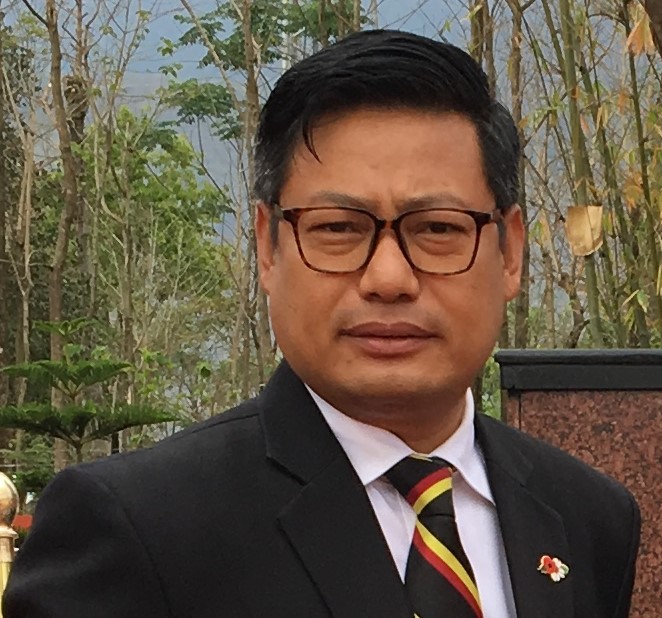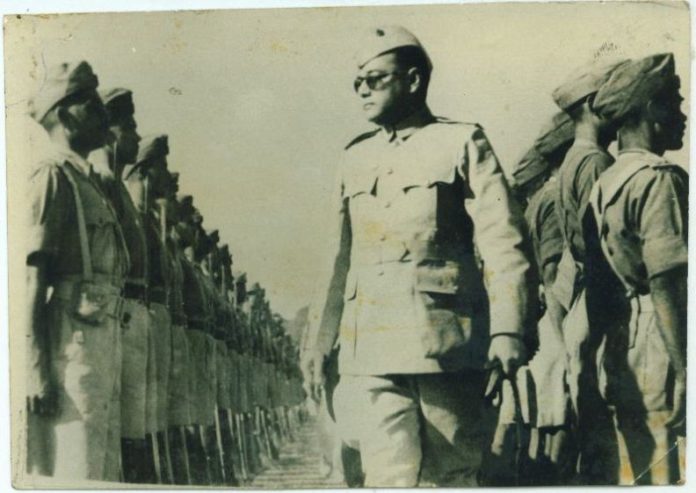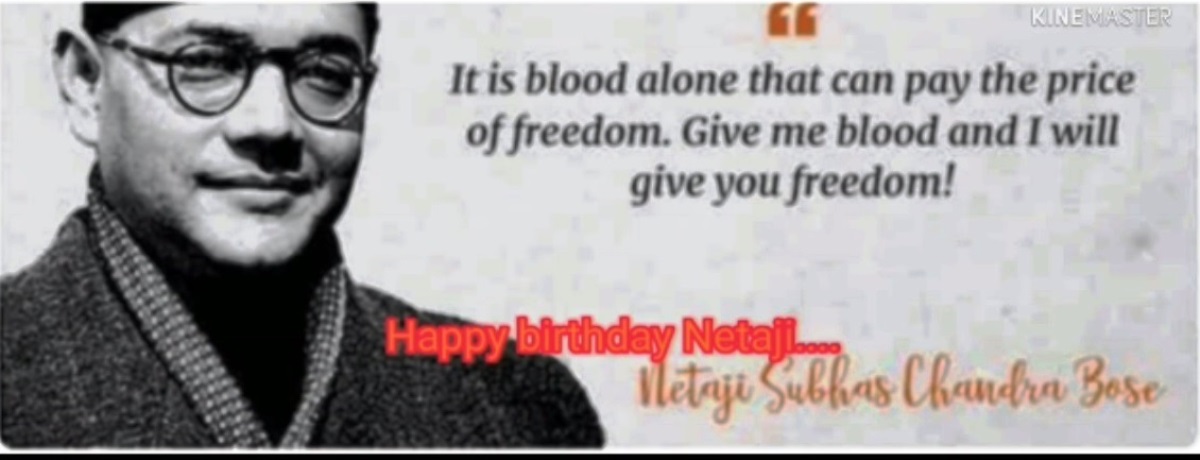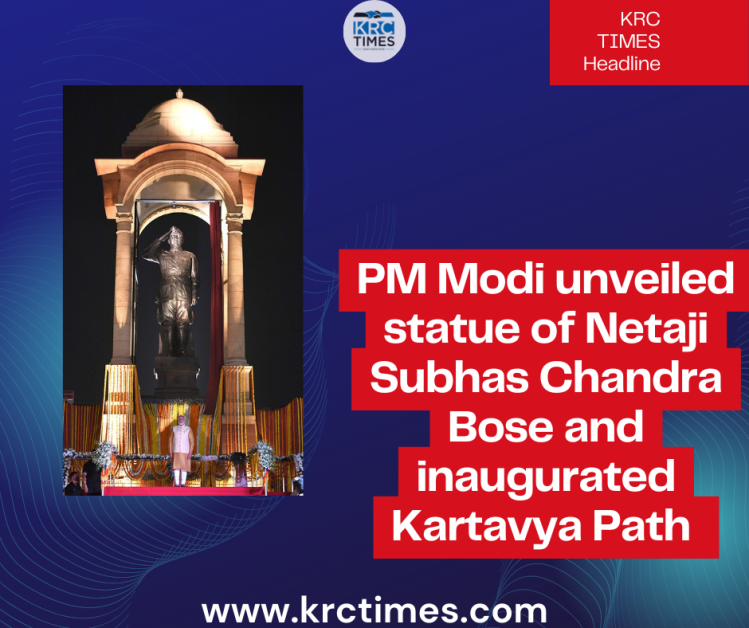I.N.A.’s Marching Song:
Kadam kadam barhaye ja;
Kushi ke geet gye ja;
Yeh zindgi hai Quom ki
Tu Quom pe lutaye ja;
Tu Sher-i-Hind age Barh,
Marne se tu kabhi na dar;
Falak talak utha ke sar
Joshe Vatan barhaye ja;
Himmat teri barhti rahe,
Khuda teri suntan rahe;
Jo samne tere chareh.
Tu khak men milaye ja;
Chalo Dilli Pukar ke;
Qaomi nishan sambhal ke;
Lal Quille gar ke,
Lehraye ja, Lehraye ja;
Yeh zindgi hai Quom ki
Tu Quom pe lutaye ja.
 Yumnam Rajeshwor Singh
Yumnam Rajeshwor Singh

Introduction
While Indians in India were struggling for political Independence, Indians in the far-Eastern countries, in particular, were also organizing and doing vigorous propaganda for her cause of freedom. In Japan, Rash Behari Bose, a veteran revolutionary and exile from India started the Indian Independence League which Anand Mohan Sahay later converted into the Indian National Congress of Japan. A branch of the same organization was opened by Swami Satyanand Puri in Bangkok in 1936 while in China was formed by the Indian National Association. In 1937 an effort was made to coordinate the efforts of these various groups at a conference which met in Tokyo under the presidentship of rash Behari Bose.
An authentic account of the Indian National Army will constitute a glorious chapter in the history of the struggle for the liberation of India from foreign domination. The Indian National Army was formed on September 1, 1942, with Captain Mohan Singh as the G.O.C- in- Chief.

Indian National Army
The Indian National Army was revived in 1943 by Subash Chandra Bose to fight for the freedom of India. The Indian National Army was very well constituted and fully organized in every sense of the word. Netaji Subash Chandra Bose was the supreme Commander, who was assisted by a War Council consisting of the following eleven members:
1. Col. J.K. Bhonsle. 2. Col. M. Z. Kiani. 3. Lt Col. Ehsan Qadir. 4. Lt Col. Aziz Ahmad Khan. 5. Lt. Col Habib-ur- Rehman. 6. Lt .Col. Gulzara Singh 7. Sri N. Raghavan 8. Sri S.A. Ayer. 9. Sri Parmanand. 10. Col. A.C. Chatterji, Secretary. 11. Sri A. Yellappa, Co-opted Member.
The Defence Department which was under the charge of Col. J.K. Bhonsle consisted of the following personnel:
1. ‘G’ Lt. Col Shah Nawaz Khan, C.G.S.S 2. Chief Administrator- Lt. Colonel A.D. Longanadan. 3. D.P.M.- Major Abdul Rashid. 4. Military Secretary- Major P.K. Sahgal 5. Finance- Captain Krishna Murti. 6. O.T.S.- Lt. Col. Habib-ur-Mulk. 7. Reinforcements- Major Mata-ul-Mulk. 8. ‘A’- Major C.J. Stracy. 9. Legal and Judicial- Captain D.C. Nag. 10. ‘Q’- Major K.P. Thimaya 11. D.M.S.- Captain S.N. Dey. 12. Establishment- Lt D.C. Dutta. 13. Enlightenment Culture- Major A.D. Jahangir.
The composition of the Indian National Army was as under:-
1. Headquarters 2. I Hind Field Group under the command of Lt. Col. S.M. Hussain. 3. Guerrilla Regiments consisting of:- (a) Bose Brigade under Lt. Col. Shah Nawaz Khan. (b) Gandhi Brigade under Lt. Col I.J. Kiani (c) Azad Brigade under Major Gulzara Singh (d) Nehru Brigade under Lt. Col Aziz Ahmad Khan.
4. Intelligence Group under Major S.A Malik. 5. Bahadur Group under Lt. Col. Burhan-ud-Din.
Rani of Jhansi Regiment.
The Women’s Organisation of the I.N.A. was also an important wing of the Army. A women’s regiment was raised in July 1943 under the command of Captain Mrs Laxmi Sawaminathan. The members of this Regiment were drawn from the Indian civilian population of South-East Asia. The Regiment was named after the famous Rani of Jhansi, who had died fighting bravely against the British forces in 1857, and consisted of 856 women trained for active service. Mrs Laxmi as the Captain of the Regiment played a unique part in inspiring and organizing the women into Red Cross units, relief squads, ambulance workers and emergency nurses.
Provisional Government of Azad Hind
Netaji’s most extraordinary move was the formation of the Provisional Government of Azad Hind. It was a master move in the game of international politics. The original Indian Independence League could not freely declare war on their enemies and could not cooperate on equal terms with the League of East Asiatic Nations. It was Netaji who foresaw the necessity of equality and thus he declared the inauguration of the Provisional Government of Azad Hind. The officers and workers remained the same but this switch over carried them overnight to the status of a free State and since then the Provisional Government of Azad Hind was recognized by nine sovereign states as an equal partner in the comity of those nations. The Nations were Germany, Italy, Japan, Croatia, Manchuria, The Philippines, The Nanking Government, Siam, Burma and the Irish Free State.
On October 21, 1943, Netaji announced the establishment of the Provisional Government of Azad Hind. The Proclamation was signed by Subash Chandra Bose as Head of State, Prime Minister and Minister for War and Foreign Affairs, Captain Mrs Lakshmi ( Women’s Organisation), S.A Ayer ( publicity and Propaganda), Lieutenant Colonel A.C Chatterji ( Finance), Lieutenant- Colonel Aziz Ahmad, Lieutenant N.S Bhagat, Lieutenant Colonel J.K. Bhonsle, Lieutenant Colonel Gulzara Singh, Lieutenant Colonel M.Z. Kiani, Lieutenant Colonel A.D Loganadan, Lieutenant Colonel Ehsan Qadir, Lieutenant Colonel Shah Nawaz ( representatives of armed forces), A.M. Sahay ( Secretary with Ministerial rank), Rash Behari Bose ( Supreme Adviser), KarimGhani, Debnath Das, D.M. Khan, A. Yellappa J. Thivy, Sardar Ishar Singh ( Advisers), and A. N. Sarkar ( Legal Adviser).
The Provisional Government of Azad Hind had nineteen different departments for administration work. Subash Chandra Bose was the Head of the State and Prime Minister. The following were some of the important departments:
1. War, (2) Foreign Affairs, (3) Finance, (4) Supply, (5) recruitment and Training, (6) Publicity and Propaganda, (7) Women’s Organisation, (8) Audit, (9) Education, (10) Public Works, (11) Health & Public Welfare, (12) Law and Order, (13) Judicature, (14) Burma Branch, (15) Post- War planning and Reconstruction.
After the establishment of the Provisional Government, the council of ministers, on October 23, 1943, passed the resolution that “the Provisional Government of Azad Hind declares war on Britain and the U.S.A”.
On February 17, 1944, at the far Eastern Asiatic Conference held at Tokyo, the Andamans and Nicobar Islands were ceded by the Japanese to the Provisional Government of Azad Hind. Accordingly, Netaji sent Colonel Loganadan as Chief Commissioner of the Island, wherewith due ceremony held at the Indian Independence League Headquarters at port Blair, the Andamans and Nicobars were formally handed over to him.
National Anthem of Azad Hind
Subh sukh chain ki barkha barse Bharat bhag hai jaga, Panjab Sind Gujarat Maratha Dravid Utkal Banga Chanchal Sagar Bindh Himala neela Jamuna Ganga, Tere nit gun gae, Tujse jeevan pae, Sab tan pae asha; Suraj ban kar jag par chamke nam Subhaga Jai-ya ho, Jai-ya ho, Jai-ho, Jai-ya jai-ya Jai-ya ho! Sabb ke dil men prit basae teri nithi bari, Har subhe ke rahne wale har mazhab ke prani, Sab god-men teri ake, Goonthen prem ki mala; Suraj ban kar jag par chamke Bharat nam Subhaga, Jai-ya jai-ya Jai-ya ho! Subha savere pankh pankheru tere hi gun gaen, Bas bhari bharpoor hawaen men rut laen, Sab mil kar Hind Pukare Jai Azad Hind ken are, Piara desh hamara, Suraj ban kar jag par chamke Bharat nam Subhaga, Jai-ya ho, Jai-ya ho, Jai- ho, Jai-ya Jai-ya Jai-ya ho !
The Indian Independence League
The Provisional Government of Azad Hind was formed on the 21st October 1943 with its headquarters in Singapore. These were shifted to Rangoon on January 7, 1944, making Singapore as the Rear headquarters to supervise the activities in Java, Sumatra, Borneo and Malaya. The Indian Independence League was retained for doing the relief work among the Indian community in these countries. It had 24 branches in Thailand, 70 branches in Malaya and 100 branches in Burma, besides having several active branches all over Java, Sumatra, Celebes, Borneo, the Philippines, China, Manchukuo and Japan, and later on even in Andamans. In Malaya, the league helped the distressed Indian Labourers who had been badly hit by war. It supplied free food, medicines and clothes to all deserving people. It also cleared 2000 acres of jungle land in Malaya for colonizing distressed Indians coming from war zones. In Thailand and Burma, it established well-equipped hospitals and free dispensaries. Another important service rendered by the League was the establishment of schools for Indian children in South East Asia. In Burma alone, it was running 65 Indian schools.
The Azad Hind Bank
The Azad Hind bank was established in Rangoon in April 1944. The money collected by the Azad Hind Government was kept in this Bank. It received donations in cash and kind which includes foodstuffs, metalware and all such things that could be of use to the Indian National Army. The returns of donations received in November 1943 showed 53, 43,956 dollars in cash ad 86310 dollars in jewellery, etc. In July 1944 the total was 1,53,54,104 dollars. Mr. Dina Nath, who was one of the Directors of this Bank once states that “ the Provisional Government of Azad Hind had also decided to finance industry and commerce in the territories under its jurisdiction. The bank had an authorized capital of 50 lakhs of rupees and a paid-up capital of 25 lakhs of rupees, the rupees being equivalent to the Japanese dollar”. More capital was not encouraged as investment facilities were limited. The transaction of the Bank extended from China to all the countries in South-East Asia, where the Azad Hind Government had been purchasing goods and equipment.
The Azad Hind currency, which was issued in various denominations, bore the signatures of Netaji Subash Bose on one side and the picture of the Taj Mahal on the other. The bank had a Board of seven directors with Mr S.A. Ayer, Propaganda Minister of the Azad Hind Government, as Chairman. Branches of the Bank in Singapore, Nicobar and the Andaman was contemplated.
Thus within a brief span of time, the Azad Hind Government was established on a quiet sound financial basis. It had resources of some 20 Crores of rupees in addition to the produce of Ziawadi Area. Ziawadi was a property about 50 square miles in area, with 15,000 inhabitants who were Indians. It had on it a sugar factory and various other means of production, agricultural or otherwise, and every branch of Administration of that territory was carried out by men appointed by the Indian National Army and belonging to the Azad Hind Dal.
Conclusion:
On taking over the Supreme Command of the Indian National Army, Netaji declared that his objective was the achievement of Independence. In the words of S. Subuhey, “the picture of India, his motherland, was always before his eyes. He had no other ambition but to liberate India from foreign domination and raise its status…. He used to work as if he were not an ordinary human being, but a superman. His power of endurance was amazing and people used to think that he had been working with so much energy only under the spell of some divine inspiration. He used to snatch little rest or sleep only for three hours in 24 hours. He was very regular and disciplined in his daily routine”
Jawaharlal Nehru once wrote, “My knowledge even then was limited and I was not quite sure in my mind as to how the formation and activities of this Army had been justified, keeping in view the wider scheme of things and the implications of the world war. But I had no doubt in my mind even then of two facts- that the men and women, who had enrolled themselves in this Army and worked under Shri Subash Chandra Bose’s guidance, had done so because of their passionate desire to serve the cause of India’s freedom”.
Nevertheless, the INA made history not only in Malaya and Burma and elsewhere but also in people’s minds all over India, and that fact will endure. When the passions of the day have colled down a very objective estimate of the I.N.A. and its leaders and the works it did will be made.
Reginald Sorenson, Member, British Parliamentary Delegation in India once said, “ In this particular case (of I.N.A), obviously there are deep political and moral considerations that may transcend precisely the legal issues. It will be in my estimation a mistake to assume that the men who had joined the Indian National Army are to be compared with the Quislings. Certainly, those who completely reject their policy do not consider them as Quislings nor as traitors”.
INQUILAB ZINDABAD! AZAD HIND ZINDABAD!
Bibliography;-
1. Shahnawaz Khan, I.N.A. & its Netaji, Rajkamal publications, Delhi 1946 2. Kusum Nair, The Story of I.N.A, Padma Publications Ltd, Bombay, 1946 3. S. Subuhey, The Story of I.N.A, Atma Ram & Sons, Lahore, 1946 4. Mohan Singh, Leaves from my Diary, Free World Publications, Lahore, 1946
(Yumnam Rajeshwor Singh is the Co-Founder of 2nd World War Imphal Campaign Foundation)





